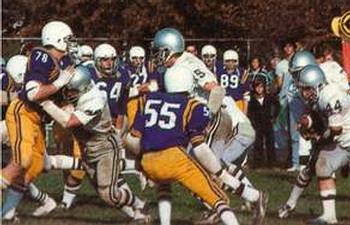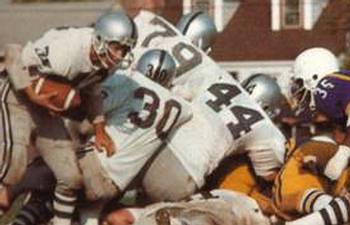

"High School Reflection"
HELMET HUT NEWS/REFLECTIONS July 2010:
By Dr. Ken
In many of my HELMET HUT HELMET NEWS/REFLECTIONS columns I have noted how important high school football was in the 1950’s and ‘60’s. It was important to the fabric of the town culture, in setting the tone for the social and academic year, and giving a central positive focus for the citizens of any locale. Being able to earn a varsity uniform held meaning because it represented a very high level of commitment and work, a willingness to sacrifice, and a definitive decision to operate as part of a team for a goal greater than one would have only for themselves. In short, football gave elevated status primarily for positive reasons and being on the high school team was truly meaningful. The thrill of wearing one’s high school helmet and jersey and jogging onto the field for warm-ups as the season unfolded, was a rite of passage and a significant milestone for numerous young men, even those who were little more than squad members who rarely played in the actual games.I attended schools in two different towns in two very different types of neighborhoods. The school related memories I have are succinctly categorized and recounted relative to the framework that football provided. Presently my wife and I contribute a great deal of our time to the children of our community, and some of it is related to athletics and some of that specifically to the football program. While I chose, or allowed football to define me as a youngster, I came to realize that among the cultural revolutionists of the mid-to-late-1960’s who were my college contemporaries, this gave me an excellent perspective on the world as it still existed. There remained, as it does today, a place for hard focused work, sacrifice for a group goal, and an ability to organize one’s time and efforts for maximum efficiency. While the so-called Hippie Revolution was putting down the pomp and circumstance of football and mocking the stereotype of the high school or collegiate coach, I understood the positives and gravitated towards everything that came with “game day” and the drudgery of the daily practice routine. As a “scrub” player, practice more than actual games presented key opportunities to hone the skills of the game and engage in unbridled combat, leading me to develop a true love of the preparatory phase, something I’m sure that led me to the high school coaching profession.
I maintained my affection for the symbols of football and specifically the helmet and jerseys as I entered that profession. I had played Little League and Pop Warner football in an unadorned white helmet until I spray painted one of those gold and added a black stripe of electrical tape, emulating the great Army teams of the late-‘50’s. Junior high school and high school were spent in a Columbia blue, and then an all yellow headpiece, both untouched by striping, numerals, or logos. The college jersey, pants, and helmet were as “big time” as it got with a one inch center stripe and lettering on each side of our head gear that gave representation to the university and city as well as a posterior positioned player identification numeral. As a coach and teacher, I wanted the young men representing their teammates, families, school, and town to be proud and excited while doing so. As an assistant coach, I was “old school” from the very first day. I pushed to streamline the offense and make it more conservative. With man-to-man coverage the era standard, I looked at the young men on the first squad I had the opportunity to work with and campaigned daily to set up our secondary in pre-rotated zones. “Rule blocking” from my perspective meant following the rules of the blocking scheme to the letter and drilling the team until they could do it asleep and blindfolded. My first coaching situation was at an upscale private school and while the young men were certainly gifted intellectually, the numbers and talent were severely limited. The restriction in my next coaching stint came hand in hand with the challenges presented by a community where more than one-third of the youngsters I dealt with daily were classified as ADC or “Aid To Dependent Children.” In foster care, on welfare, or otherwise under the supervision of various state agencies, the school facilities, academic achievement, and often intelligence or emotional stability of the young men posed an array of problems.
If there were to be any “frills” it would come with the uniform, despite respecting the words of the immortal Paul Brown who had said that there was nothing worse than a bad team dressed in an attention getting uniform.
|
|
The game itself had begun to change in the years between my high school graduation and entry into the teaching and coaching professions. The increase of televised games on both the collegiate and professional level resulted in the proliferation of altered uniforms. Most HELMET HUT readers know that the television contracts of the early 1960’s sparked the change in exterior helmet design. As a high school player, our “plain” one color helmets were quite typical and even the “fanciest” of helmets may have been decorated with a single one-inch center stripe of a contrasting color, and identifying player numerals on either the sides or rear of the shell. The increased popularity of professional football and the escalating battle between the American and National Football Leagues directly stimulated changes in high school helmet striping and overall display. Typical of my own high school opponents, the helmets worn were royal blue with a white one-inch center stripe; white with a royal blue one-inch center stripe; white with a scarlet red one-inch center stripe; black with a gold one-inch center stripe; and navy blue with a yellow one-inch center stripe.
|
|
The black shell with contrasting orange center stripe of East Rockaway, N.Y. HS was the standard appearance in 1962
Some of the helmets, in some of the years, may have featured player identifying numerals but as a player, the helmets in our area had little to distinguish their designs. In my first two years of coaching high school football, I witnessed helmets that very much mimicked the more popular collegiate and professional teams.
|
|
This Chaminade Flyer and his teammates maintained the more conservative look while his supine opponent demonstrates what became in the late 1960's a "more modern" appearance.
While I could not recall any school in our area utilizing silver as a primary school color or including it as part of their uniform design during the time I played, silver was seen as a uniform “highlight color” with increasing frequency and shockingly, fully adopted as a primary uniform color even for schools that had never before noted silver as any part of the official school designs.
 |
 |
With official school colors of royal blue and white, Oceanside, NY High School was suddenly bathed in silver.
I made the decision to “upgrade” our team’s uniforms and it was something I would do annually, giving the players and fans one more thing to look forward to each season.